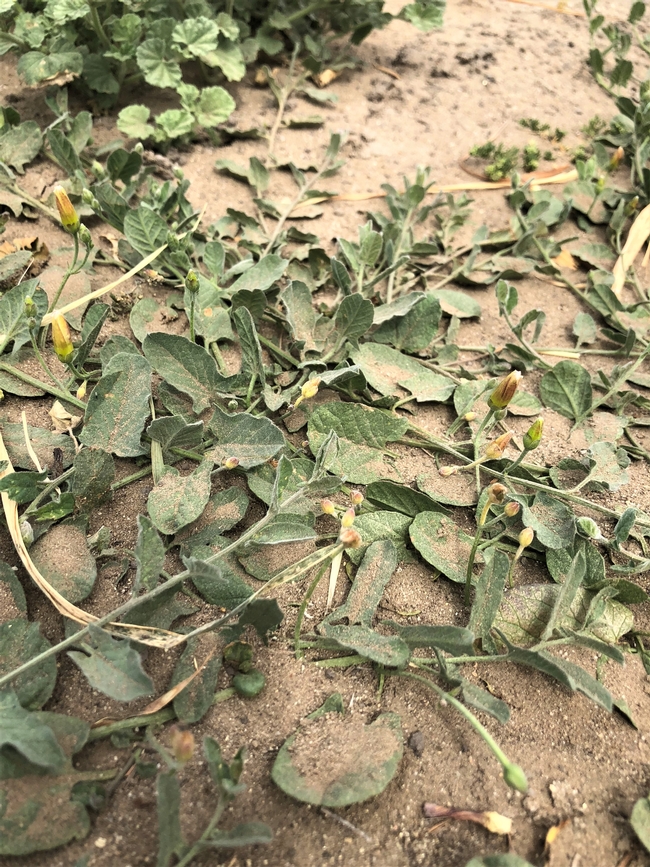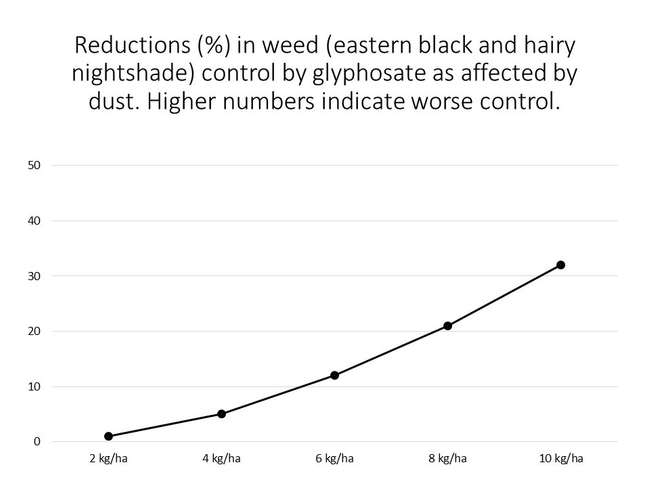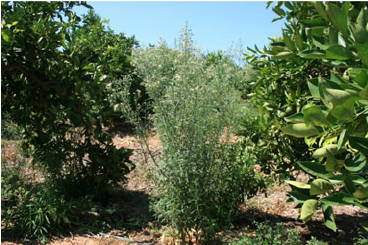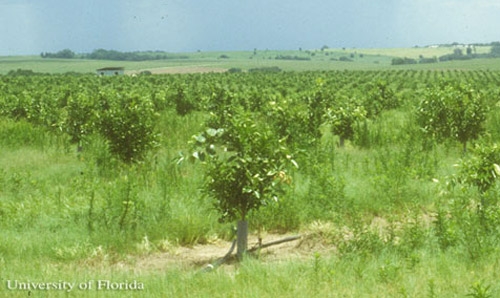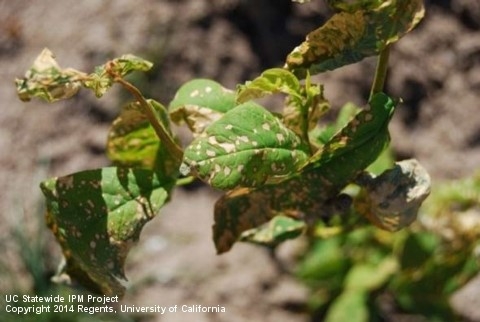
Posts Tagged: pesticide
Pesticide Safety Training - English/Español - Seguridad de Pesticidas
Pesticide Safety Instructor TrainingWorkshops
Update your knowledge of changing regulations!
Registration:
http://ipm.ucanr.edu/IPMPROJECT/workshops.html
This course meets the requirements established by the revised Worker Protection Standard, which is mandated by the US Environmental Protection Agency and the California Department of Pesticide Regulation. This workshop, presented by the UC Integrated Pest Management Program, AgSafe and support from WCAHS, will qualify participants who successfully complete the program to train fieldworkers and pesticide handlers under these revised regulations. Topics will cover pesticide exposure, signs and symptoms of illness, emergency medical care, proper use of personal protective equipment, safe handling and transportation of pesticides, and laws and regulations regarding labels and safety data sheets.
Who Should Attend?
Ag supervisors • Growers • Farm Labor Contractors • Safety Managers • Safety Trainers
Cost
$50 per person. Payment is by credit card only.
Continental breakfast, lunch and materials provided. Includes a certificate of completion.
No refunds will be given.
Space is limited, register early!
http://ipm.ucanr.edu/IPMPROJECT/workshops.html
Dates
Classes will be from 8:00 a.m. – 5:00 p.m. Check-in begins at 7:45am.
January 29
Modesto
English
February 20
Vista
English
February 15
Modesto
Spanish
February 20
Vista
Spanish
February 12
Santa Paula
English
April 16
Fresno
English
February 13
Santa Paula
Spanish
April 18
Fresno
Spanish
Continuing Education hours will be available through California Department of Pesticide Regulations (DPR).
Seguridad de Pesticidas Talleres de Formación de Instructores
Actualicé su conocimiento sobre los cambios regulatorios!
Este curso cumple con los requisitos revisados por la Norma de Protección del Trabajador, que es un mandato de la Agencia de Protección Ambiental de Estados Unidos y el Departamento de Regulación de Pesticidas de California. Este taller, presentado por el Programa de Manejo Integrado de Plagas de la Universidad de California y AgSafe, con apoyo de WCAHS, calificará a los participantes que completen el programa con la capacidad de entrenar a trabajadores de campo y manejadores de pesticidas bajo estas regulaciones revisadas. Los temas cubren la exposición a plaguicidas, síntomas de la enfermedad, la atención médica de emergencia, el uso adecuado del equipo de protección personal, manipulación y transporte seguro de los plaguicidas y las leyes y reglamentos relativos a las etiquetas y fichas de datos de seguridad.
¿Quién debeasistir?
Supervisores agrícolas • Productores • Contratistas de trabajadores agrícolas Supervisores de seguridad • Entrenadores de seguridad
Costo
$50 por persona. El pago es solamente con tarjeta de crédito.
Desayuno, almuerzo y los materiales serán proporcionados. Incluye un certificado de finalización. No se darán reembolsos.
¡El espacio es limitado, regístrese temprano!
Fechas
Clases empiezan a las 8:00 a.m. – 5:00 p.m. Registración empieza a las 7:45am.
29 de enero
Modesto
Inglés
20 de febrero
Vista
Inglés
15 de febrero
Modesto
Español
21 de febrero
Vista
Español
12 de febrero
Santa Paula
Inglés
16 de abril
Fresno
Inglés
13 de febrero
Santa Paula
Español
18 de abril
Fresno
Español

danger sign
Dust and Roundup
Agronomy and Weed Science Advisor, Merced County
It's getting hot and dry in the Central Valley and the movement of equipment in and out of fields/orchards/vineyards has the potential to stir up a significant amount of dust. Among its other impacts to agriculture (soil erosion, tissue damage, reduced photosynthesis, etc...), wind blown dust can reduce the efficacy of glyphosate, which is an important tool for the management of weeds in trees and vines, along rights-of-ways, and in glyphosate-tolerant agronomic crops (e.g. corn, cotton, alfalfa) in CA.
The adoption of glyphosate has been facilitated, at least in part, by it's relative lack of soil activity (Miller et al. 2013; Zhou et al. 2006). Glyphosate can become tightly adsorbed to soil particles (depending on clay and organic matter content, pH, cation exchange capacity, etc...), thereby reducing the potential for crop injury via root uptake. The ability of glyphosate to bind to soil also contributes to it's reduced efficacy in certain situations. Specifically, dust that settles on weed leaf surfaces (Figure 1) can negatively impact glyphosate performance due to binding/inactivation.
Figure 1. Dirt on field bindweed (Convolvulus arvensis) leaves
The detrimental effects of dust on glyphosate performance have been described by Zhou et al. (2006) and Boerboom et al. 2006). Results from Zhou et al. (2006) showed that dust applied to the surface of eastern black (Solanum ptychanthum) and hairy (Solanum sarrachoides) nightshades reduced weed control, with greater amounts of dust resulting in greater reductions in herbicide efficacy (Figure 2). In a study conducted by Boerboom et al. (2006), dust was deposited over the tops of plots of common lambsquarters (Chenopodium album); water was then used to remove the dust treatment from ½ of the plots prior to a glyphosate application. Similar to the results achieved by Zhou et al. (2006), the occurrence of dust visually reduced common lambsquarters control (relative to the plots where the dust had been washed away). Results from both sets of studies show that dust generation has the potential to significantly impact glyphosate performance'
Figure 2. Percent reduction in weed control by glyphosate as affected by the rate of a silty clay dust applied to the leaves of two nightshade species. Greater numbers on the Y-axis indicated greater reductions in control.
Adapted from Zhou et al. (2006) Weed Science 54:1132-1136.
A few closing thoughts about dust and it's impact on weed control:
- Be mindful of how soil disturbance (cultivation, farm traffic, etc...) affects dust production.
- Make glyphosate applications in advance of crop production events that are likely to generate substantial amounts of dust.
- Sprinkler irrigation may be able to remove dust from the leaves of weeds under some situations. Glyphosate applications should be made after the leaves have dried but before more dust can be deposited.
- Soil particles in spray water can also bind to glyphosate and reduce herbicide efficacy; only clean water should be used to fill spray tanks. (Not actually dust related, but a good practice to remember)
Citations:
Boerboom, C. et al. (2006) Factors affecting glyphosate control of common lambsquarters. Proceedings of the North Central Weed Science Society 61:54.
Miller, T. et al. (2013) Glyphosate stewardship: Maintaining the effectiveness of a widely used herbicide. ANR Publication 8492. https://anrcatalog.ucanr.edu/pdf/8492.pdf
Zhou, J. et al. (2006) Soil dust reduces glyphosate efficacy. Weed Science 54:1132-1136.
Note: An earlier version of this post is available at the following website: http://treefruit.wsu.edu/dust-can-affect-weed-control-with-glyphosate/
And Now Paraquat
A recent call about the poor control of marestail (horseweed, Conyza canadensis) to glyphosate (Roundup®) wasn't surprising, but that paraquat didnt do the trick was. It turns out that there is multiple resistance to the materials. If horseweed is resistant to glyphosate it is possibly going to be resistant to paraguat which also means that hairy fleabane which has glyphosate resistance could also show resistance to paraquat. A recent study reports on the increased Conyza resistance to paraquat (Distribution of Conyza sp. in Orchards of California and Response to Glyphosate and Paraquat, Moretti et al, https://doi.org/10.1614/WS-D-15-00174.1):
Resistance to glyphosate in hairy fleabane and horseweed is a problem in orchards and vineyards in California. Population genetic analyses suggest that glyphosate resistance evolved multiple times in both species, but it is unknown if resistance to other herbicides is also present. Two approaches of research were undertaken to further evaluate herbicide resistance in Conyza sp. in the perennial crop systems of California. In the initial study, the distribution of Conyza sp. in the Central Valley, using a semistructured field survey, was coupled with evaluation of the presence and level of glyphosate resistance in plants grown from field-collected seed. In a subsequent study, single-seed descendants representing distinct genetic groups were self-pollinated in the greenhouse and these accessions were evaluated for response to glyphosate and paraquat. Conyza sp. were commonly found throughout the Central Valley and glyphosate-resistant individuals were confirmed in all field collections of both species. The level of glyphosate resistance among field collections varied from 5- to 21-fold compared with 50% glyphosate resistance (GR50) of the susceptible, with exception of one region with a GR50 similar to the susceptible. When self-pollinated accessions from different genetic groups were screened, the level of glyphosate resistance, on the basis of GR50 values, ranged from 1.7- to 42.5-fold in hairy fleabane, and 5.9- to 40.3-fold in horseweed. Three accessions of hairy fleabane from different genetic groups were also resistant to paraquat (40.1- to 352.5-fold). One glyphosate-resistant horseweed accession was resistant to paraquat (322.8-fold), which is the first confirmed case in California. All paraquat-resistant accessions of Conyza sp. identified so far have also been resistant to glyphosate, probably because glyphosate resistance is already widespread in the state. Because glyphosate and paraquat resistances are found across a wide geographical range and in accessions from distinct genetic groups, multiple resistant Conyza sp. likely developed independently several times in California.
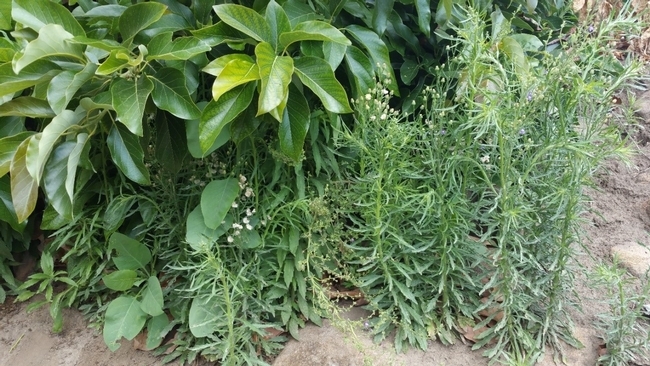
conyza avocado
Area-Wide Treatments for Ventura ACP
For the past 18 months, a team led by University of California research entomologist Beth Grafton-Cardwell has been conducting an Asian citrus psyllid monitoring project to determine the efficacy of Ventura County's area-wide ACP suppression strategy. Based on her analysis of the survey data, Dr. Grafton-Cardwell has recommended changes in the area-wide management (AWM) protocol to provide better control of the invasive pest. The Ventura County ACP-HLB Task Force has endorsed her recommendations and incorporated them into the AWM schedule for 2018-2019.
The primary change will be the addition of a second fall treatment, which may be a perimeter spray, for lemons and mandarins. Fall is when ACP populations reach their highest level, and the research data indicate a single pesticide application is inadequate. The research data also show that ACP is most abundant on grove perimeters, and only expands into the center rows when the population is large. In recognition of this, the new Task Force protocol allows one of the two fall applications to be applied to only the grove perimeter, as long as the grower, grove manager or PCA/PCO has scouted the orchard and determined that center rows are free of ACP nymphs on flush. The other fall application, however, must cover the entire grove.
As in previous cycles, the treatment window for each psyllid management area (PMA) will last three weeks, but it now will overlap with the next window by two weeks instead of one. This will compress each treatment cycle from four months in length to two and a half months, heightening the area-wide effect. (See below for the schedule.)
The annual AWM program for lemons and mandarins will now consist of four applications: a coordinated AWM whole-orchard treatment in winter, individual applications of an ACP-effective material (either alone or piggybacked on a spray for another pest) in late spring-early summer, and two coordinated AWM treatments in late summer and fall (one of which may be a perimeter spray).
The annual cycle for oranges, which do not flush year-round, remains two coordinated applications, one during the first fall window and one in the winter. For organic growers, each "treatment" must consist of two applications of Entrust and oil or Pyganic and oil, or other approved alternative material, to compensate for their limited residual activity. The list of approved materials for both conventional and organic operations is at http://ipm.ucanr.edu/PMG/r107304411.html.
Members of the Ventura County citrus community are invited to a workshop to learn more about these changes, and the research data upon which they are based. The workshop will be from 9:30 to 11:30 a.m. on Thursday, April 26, at the Agriculture Museum, 929 Railroad Ave., Santa Paula. Attendance is free, but advance registration is required. Please register online at: https://vctaskforce-workshop.eventbrite.com.
During the workshop, Dr. Grafton-Cardwell will present findings from her continuing survey of ACP populations across the county, including data on the effects of AWM pesticide treatments on ACP abundance. Other speakers will present updates on the statewide Citrus Pest and Disease Prevention Program, the status of Huanglongbing disease in California, and grower participation in the local ACP suppression effort.
The Task Force is also planning outdoor workshops to help grove owners, managers or farm employees develop an effective ACP scouting strategy. Topics will include how to scout for ACP, and how to identify symptoms of HLB. More information will be distributed in coming weeks.
The following is the new schedule for Fall 2018 and Winter 2019 treatments, organized by groups of PMAs. Overview maps of Ventura County's PMA boundaries are available at http://www.farmbureauvc.com/issues/pest-issues/asian-citrus-psyllid#task-force.
Individual maps of Ventura County's PMA boundaries, along with many other documents pertaining to the Ventura County AWM program, can be viewed or downloaded at
As was the case with the previous AWM treatment cycles, growers will be notified about the date of their treatment window either by their packinghouse field reps, their PCAs or by the Ventura County grower liaisons: Sandra Zwaal (szwaal2@gmail.com) and Cressida Silvers (cressidasb@gmail.com). It will be up to growers to work with their PCAs and applicators to schedule those treatments.

ACP adult and nymph
What's that Weed? And What Does Herbicide Damage Look Like?
Plant-out-of-place photo galleries:
http://wric.ucdavis.edu/photo_gallery/photo_gallery.htm
http://ipm.ucanr.edu/PMG/weeds_intro.html
Horseweed - Conyza canadensis
Herbicide treatment table for citrus:
http://ipm.ucanr.edu/PMG/r107700411.html
And if you are wondering what herbicide damage might look like on various plant species (this is heavily weighted to annuals and landscape plants):
http://herbicidesymptoms.ipm.ucanr.edu/index.cfm
Blueberry herbicide damage

